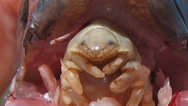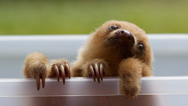Sea Cucumber Evisceration
- By Anna Rothschild
- Posted 04.09.15
- NOVA
Sea cucumbers can eviscerate themselves, shooting their internal organs through either their head or butt (depending on the species.) If we could figure out how sea cucumbers regrow their lost body parts, maybe we could stimulate our own bodies to regrow lost limbs or heal other serious injuries. Explore more in this episode of Gross Science from NOVA.
Transcript
Sea Cucumber Evisceration
April 9, 2015
If your intestines came shooting out of your butt, you’d probably be pretty upset. But if you were a sea cucumber, that might just be a normal Tuesday.
I’m Anna Rothschild, and this is Gross Science.
Sea cucumbers are marine animals that live in oceans all over the world. They come in a variety of shapes, sizes, and colors, but apart from that they don’t exactly seem like the most charismatic creatures—they spend most of their time inching along the sea floor looking for tasty bits of debris to eat.
But every so often, a sea cucumber will do something totally unexpected--it will eviscerate itself, shooting out its internal organs. This is a process called autotomy, and depending on the species, it can happen in a few different ways. Some species will shoot their intestines, along with some other organs, through their head, while others will shoot them out of their cloaca (which is essentially their butt.)
Now, no one’s quite sure why evisceration happens. It could be to flush out parasites, to withstand times of stress—like when the oxygen levels in the water get too low—or possibly to avoid predation. However, just a side note: some sea cucumbers have a separate set of organs they expel when attacked, called Cuvierian Tubules, and for more on that, check the links below.
Anyway, despite how violent this behavior is, sea cucumbers not only survive evisceration, they’re actually able to regenerate their lost organs. Certain cells in their body “dedifferentiate.” This is a complicated idea, but essentially it means that the cells stop performing their current function, and become capable of doing anything the body requires. These dedifferentiated cells then migrate and start to regrow the lost organs, starting with the gut. And just a few weeks later, the sea cucumber will be good as new.
This regeneration process is totally exciting to scientists. If they could figure out how sea cucumbers dedifferentiate their cells, maybe they could stimulate human cells to do the same thing. If they could, people might one day be able to regrow lost limbs or heal serious spinal injuries. We’re still a long way off, but in the meantime, scientists are studying sea cucumbers, and watching them spill their guts.
Ew.
Credits
PRODUCTION CREDITS:
- Host, Writer, Animator, Editor
- Anna Rothschild
- DP, Sound, Intern Extraordinaire
- Elizabeth Gillis
- Videos of Sea Cucumber Evisceration
- Courtesy Jose Garcia-Arraras
- Special Thanks to Jose Garcia-Arraras
- Music Provided by APM
MEDIA CREDITS
- Euapta godeffroyi1
- Wikimedia Commons/François Michonneau
- Soldier with Prosthetic Limb at the Personnel Recovery Centre in Edinburgh MOD 45152288
- Wikimedia Commons/Sgt Ian Forsyth RLC
- Thelenota ananas
- Wikimedia Common/Leonard Low from Australia
- Treasure chest candycane sea cucumber 2
- Wikimedia Commons/q phia
- Tubes de Cuvier émis par Holothuria pervicax
- Wikimedia Commons/Philippe Bourjon
- Vert7 (10818457336) Wikimedia Commons/University of Liverpool Faculty of Health from Liverpool, United Kingdom
- Cockroaches
- Freesound/StateAardvark
(used with permission from author) - Squeak Pack/squeak_10
- Freesound/Corsica_S
- Bubbles Popping
- Freesound/Ch0cchi
- Swish_unwrap_fast
- Freesound/goldendiaphragm
- Wink
- Freesound/bennychico11
- Produced by WGBH for PBS Digital Studios
SFX
IMAGE
- (main image: sea cucumber animation)
- © WGBH Educational Foundation
Related Links
-

The Three-Foot-Long Footworm
Guinea worms have plagued humans for millennia, but they’re almost extinct.
-

What Does Disease Smell Like?
Sometimes doctors can diagnose you based on how you smell.
-

The Tongue-Eating Parasite
Gross science: This parasite crawls into a fish's mouth and replaces its tongue. Enough said.
-

Poop-Eating Sloth Moths
Sloths may be cute, but they're covered in a surprising number of creepy crawlies.

